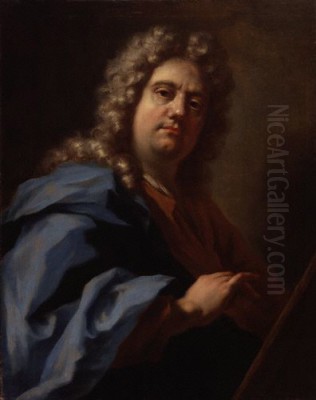
Giovanni Antonio Pellegrini (1675–1741) stands as one of the most significant Venetian history painters of the early 18th century. His prolific career, marked by extensive travel and prestigious commissions across Europe, played a pivotal role in the transition from the grandeur of the late Baroque to the lighter, more elegant Rococo style. Pellegrini masterfully synthesized the rich painterly traditions of Venice, particularly the decorative brilliance of Paolo Veronese, with the dynamic energy of Baroque masters like Pietro da Cortona and Luca Giordano, forging a distinctive style that found favour in courts and aristocratic homes from London to Vienna.
Early Life and Artistic Formation
Born in Venice in 1675, Pellegrini's origins were modest; his father was a shoemaker originally from Padua. This background, however, did not impede his artistic inclinations. Around 1690, the young Pellegrini entered the workshop of the Milanese painter Paolo Pagani. Pagani, known for his somewhat eccentric and dynamic late Baroque style, provided Pellegrini with his foundational training. This apprenticeship involved travel, as Pellegrini accompanied Pagani to Moravia and Vienna, broadening his horizons beyond Venice early in his development.
By 1696, Pellegrini had returned to his native Venice. It was during this period, between 1696 and his departure for Padua around 1699-1700, that he likely created his earliest surviving independent works. These initial efforts began to show the assimilation of his training and the burgeoning influence of the Venetian artistic milieu. He spent time in Padua and later Rome, further absorbing the artistic currents of Italy before embarking on the international phase of his career.
The Venetian Heritage and Emerging Style
Pellegrini's art is deeply rooted in the Venetian colourist tradition. The influence of the great 16th-century master Paolo Veronese is palpable in the luminosity, decorative richness, and opulent feel of many of Pellegrini's compositions. Veronese's large-scale narrative scenes, filled with vibrant colour and elegant figures, provided a lasting model for Venetian artists seeking to create grand decorative schemes.
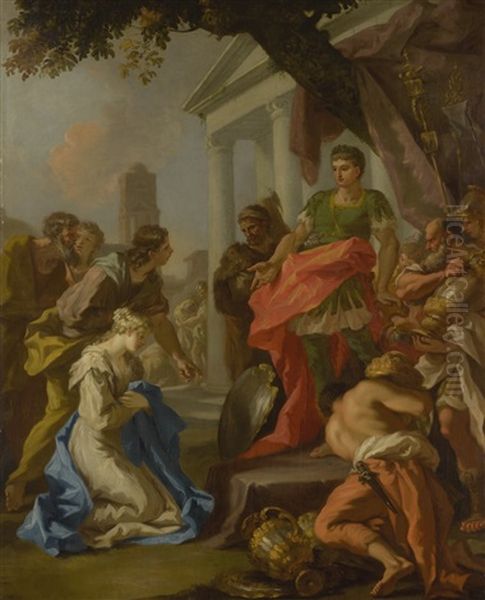
However, Pellegrini did not simply imitate the past. He infused the Veronese model with the dynamism and fluid brushwork characteristic of the late Baroque, particularly drawing inspiration from the works of Pietro da Cortona and the Neapolitan painter Luca Giordano. Giordano, known for his astonishing speed of execution (fa presto) and his ability to synthesize various styles, had a profound impact on many artists of the period, including Pellegrini. This fusion resulted in a style that was lighter, airier, and more fluid than the high Baroque, characterized by bright, often silvery tonalities, rapid brushwork, and graceful, elongated figures.
In Venice, Pellegrini emerged alongside other significant painters like Sebastiano Ricci and Jacopo Amigoni. Ricci, slightly older and initially more established, became both a contemporary and a rival. While both artists worked in a late Baroque/early Rococo vein, Pellegrini's style was generally considered lighter and more decorative, whereas Ricci often retained a greater sense of Baroque solidity and drama. Their paths would cross significantly, particularly during their time in England.
An International Career: England
Pellegrini's reputation grew, attracting attention beyond Italy. In 1708, Charles Montagu, the 4th Earl (and later 1st Duke) of Manchester, invited Pellegrini to England. Montagu, serving as British ambassador to Venice, recognized the artist's talent for the large-scale decorative work favoured by the aristocracy. Pellegrini travelled to England, accompanied by Marco Ricci, the nephew of Sebastiano Ricci and a notable landscape painter.
His most significant commission during this period was the decoration of Kimbolton Castle, the Duke of Manchester's country seat. Pellegrini adorned the main staircase and the chapel with elaborate allegorical and historical scenes, showcasing his fluid style and bright palette. These works were highly successful and established Pellegrini as a leading decorative painter in England, contributing significantly to the introduction of the continental Rococo taste. He received numerous other commissions for wall and ceiling paintings in aristocratic houses.
His time in England also saw direct competition with Sebastiano Ricci, who arrived shortly after Pellegrini. Both Venetians vied for prestigious commissions. A notable instance was the project to decorate the dome of the newly rebuilt St. Paul's Cathedral in London. Both Pellegrini and Ricci submitted designs, but ultimately the commission was awarded to the English painter Sir James Thornhill, perhaps reflecting a preference for a native artist or a more restrained Baroque style than the flamboyant Venetian manner offered by Pellegrini. Despite this setback, Pellegrini's English sojourn (1708-1713) cemented his international reputation.
Travels Across Continental Europe
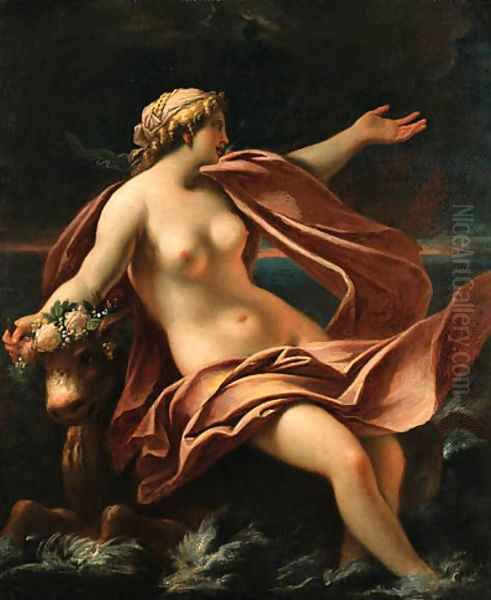
Leaving England in 1713, Pellegrini embarked on a series of journeys that took him across continental Europe, fulfilling commissions for various patrons. He travelled first to Düsseldorf, where he worked for the Elector Palatine Johann Wilhelm, a significant patron of the arts. For the Elector's Schloss Bensberg, Pellegrini executed a series of large allegorical ceiling paintings, further demonstrating his skill in grand-scale decoration. These works are considered among his finest achievements.
His travels continued to the Low Countries. Between 1716 and 1718, he was active in Antwerp and The Hague. A major commission during this time was the decoration of the "Golden Room" (Gouden Zaal) in the Mauritshuis in The Hague. This ensemble of wall and ceiling paintings, featuring mythological scenes executed with characteristic lightness and elegance, remains an important example of his decorative work in situ.
Pellegrini's itinerary also included Paris around 1720. Here, he was admitted to the prestigious Académie Royale de Peinture et de Sculpture. His reception piece was likely an allegorical painting showcasing his mature style. During his time in Paris, he associated with French artists and patrons, potentially encountering figures like Antoine Watteau, whose fêtes galantes represent the pinnacle of French Rococo. Pellegrini's presence, along with that of his sister-in-law, the celebrated pastellist Rosalba Carriera, contributed to the cross-cultural artistic exchanges of the era. He also worked briefly in Vienna and possibly Prague, further extending his reach into Central Europe.
Mature Style and Artistic Characteristics
Throughout his extensive travels, Pellegrini refined his signature style. His work is characterized by its remarkable fluidity and prestezza – a sense of rapid, effortless execution. His brushwork is often loose and visible, contributing to the shimmering, atmospheric quality of his paintings. He favoured a high-keyed, luminous palette, often employing pastel shades, silvery blues, pinks, and yellows, which enhanced the decorative and ethereal nature of his scenes.
His figure drawing is elegant and graceful, often featuring elongated forms and dynamic, swirling compositions. While capable of depicting dramatic historical or religious narratives, the emphasis is frequently on decorative harmony and sensual appeal rather than profound psychological depth or intense emotion. Mythological subjects, allegories, and scenes from ancient history provided ample opportunity for him to display his skill in rendering graceful figures, rich fabrics, and atmospheric settings.
Pellegrini was primarily a history painter, tackling large-scale narrative subjects, but he also produced smaller easel paintings. His output includes religious scenes, mythological narratives, allegories, and historical episodes. Regardless of the subject, his approach consistently emphasized visual delight, movement, and light.
Key Works and Themes
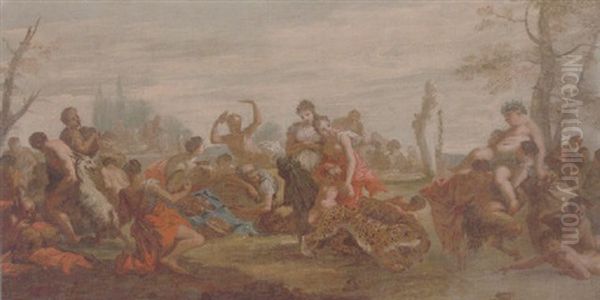
Pellegrini's vast oeuvre includes numerous significant works spread across Europe. Beyond the large decorative cycles at Kimbolton, Bensberg, and the Mauritshuis, several individual paintings stand out:
The Trinity with Saint Joseph and Saint Francis of Paola: This religious work exemplifies his ability to handle sacred themes with Rococo grace and luminosity, combining divine figures with earthly saints in a harmonious composition.
Bacchus and Ariadne: A popular mythological subject, Pellegrini's rendition likely emphasized the sensuousness and celebratory aspects of the story, rendered with his characteristic light touch and vibrant colour.
Mucius Scaevola Before Porsenna: Depicting the Roman hero thrusting his hand into fire, this subject allowed Pellegrini to explore themes of bravery and stoicism within a historical narrative framework, likely focusing on the dramatic gesture and the reactions of the onlookers.
Bellona: This depiction of the Roman goddess of war would have provided an opportunity to portray a strong, dynamic female figure, perhaps combining martial attributes with Rococo elegance.
Justice Overcoming Vice (or similar allegories): Allegorical subjects were a staple of decorative programs, allowing artists like Pellegrini to create visually engaging compositions embodying abstract virtues or concepts.
Alexander the Great and Diogenes: This encounter between the powerful ruler and the ascetic philosopher offered a contrast in character and status, which Pellegrini would interpret through gesture and composition.
Design for a Ceiling: Allegories of the Four Continents: This surviving sketch, possibly unfinished or a preparatory study, offers insight into his working process for large ceiling decorations. The allegorical representation of the continents was a common theme in Baroque and Rococo art, symbolizing global power or reach. The sketch's unfinished nature adds an element of mystery regarding its intended location or final form.
Personal Life and Connections
In 1704, Pellegrini married Angela Carriera, the sister of the renowned Venetian pastellist Rosalba Carriera. This connection brought him into closer contact with Rosalba, a leading figure in European portraiture. They sometimes travelled together, notably to Paris, and the association likely benefited both artists professionally and personally. Rosalba's delicate pastel portraits shared a certain Rococo sensibility with Pellegrini's paintings.
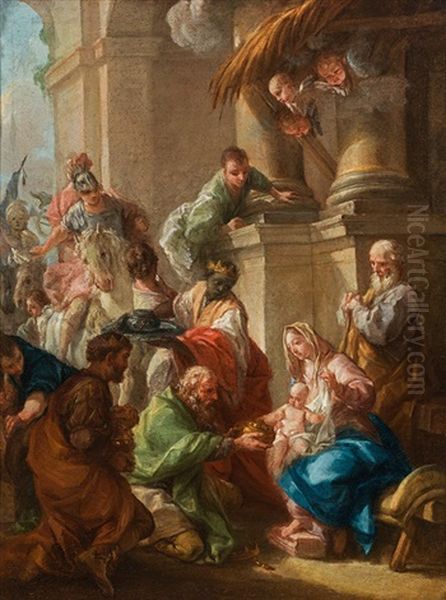
Pellegrini also took on students, although he is not primarily remembered as a teacher. One notable pupil was Antonio Visentini, who later became known for his architectural paintings (vedute) and engravings, particularly his collaborations with Canaletto. This indicates Pellegrini's role in transmitting artistic knowledge within the Venetian context.
Anecdotes surrounding Pellegrini include the minor controversy or confusion regarding his birth name, possibly recorded as "Carlo Gio Batta Pellegrini," suggesting Giovanni Battista. There was also the matter of attribution disputes concerning works potentially by him or his workshop, a common issue for prolific artists with international careers, as highlighted by later examinations of collections like that of the Blanton Museum.
Later Years and Legacy
After his extensive travels, Pellegrini eventually returned to Venice, though he continued to undertake commissions elsewhere, including Germany and Austria. He remained active into his later years, his style influencing a younger generation of Venetian painters. He died in Venice in 1741.
Giovanni Antonio Pellegrini's primary contribution to art history lies in his role as a key propagator of the Venetian Rococo style across Europe. His light, airy, and decorative manner offered an appealing alternative to the heavier forms of the Baroque and found favour with aristocratic patrons seeking elegance and modernity. His fluid brushwork and luminous palette were particularly influential.
He is widely regarded as an important precursor to the greatest Venetian decorative painter of the 18th century, Giovanni Battista Tiepolo. Pellegrini's large-scale ceiling frescoes, with their open compositions and light-filled atmospheres, paved the way for Tiepolo's even more ambitious and spatially complex works. While Tiepolo achieved greater dramatic power and compositional complexity, Pellegrini's pioneering efforts in developing and disseminating this new decorative language were crucial. His influence can also be seen in the work of contemporaries like Jacopo Amigoni, who also enjoyed an international career painting in a similar Rococo vein.
Conclusion
Giovanni Antonio Pellegrini was a central figure in early 18th-century European art. A product of the rich Venetian tradition, he skillfully blended the legacy of Veronese with the innovations of the late Baroque to create a fresh, elegant, and highly sought-after Rococo style. His extensive travels and prestigious commissions – from English country houses to German palaces and Dutch townhouses – made him a truly international artist who played a significant role in shaping the decorative tastes of the era. Though sometimes overshadowed by his great successor, Tiepolo, Pellegrini remains a vital figure, an artist whose luminous and graceful works capture the spirit of the burgeoning Rococo age and whose career exemplifies the cosmopolitanism of 18th-century European art.